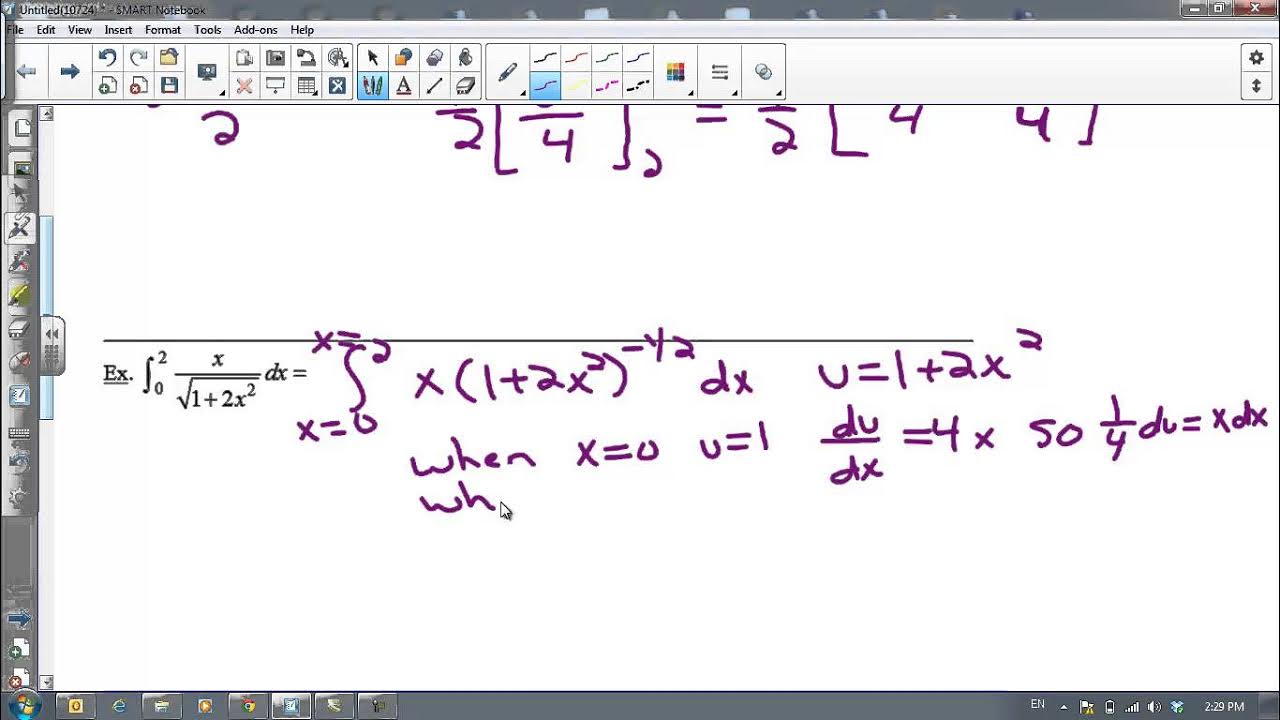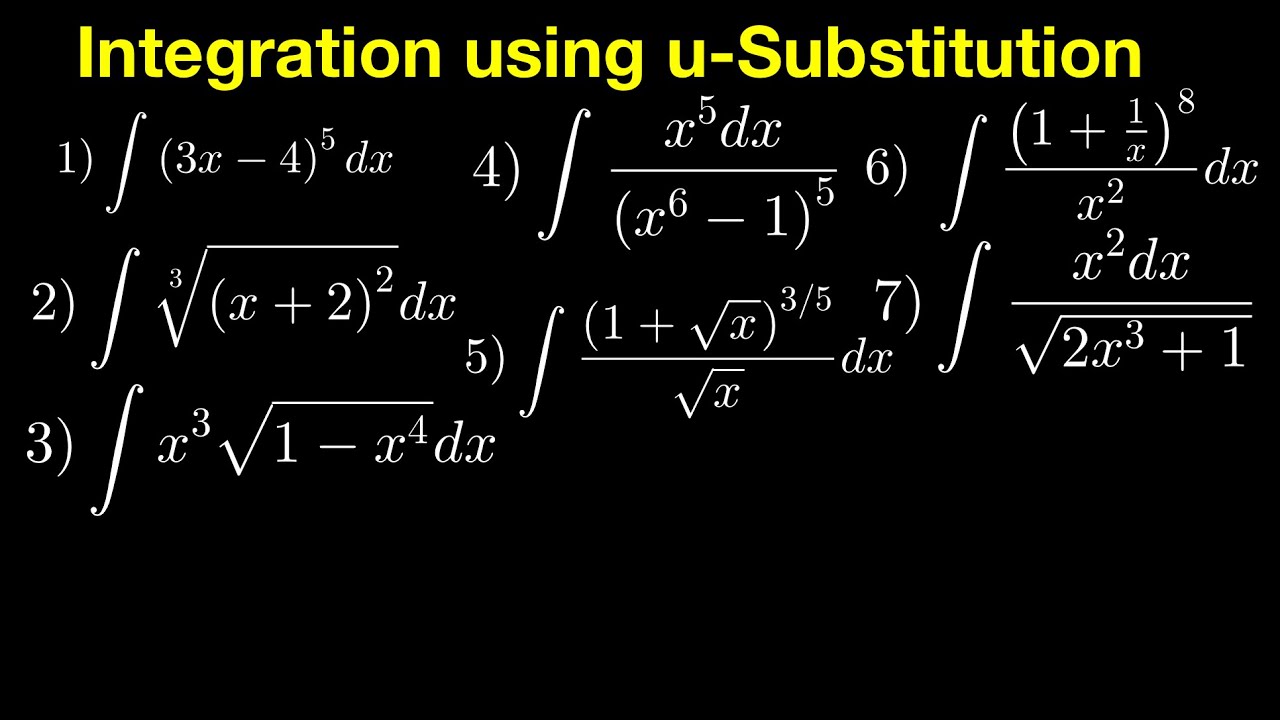Integration of Rational Functions By Completing The Square - Calculus
TLDRThis educational video script focuses on integrating rational functions by completing the square and utilizing specific integration formulas for inverse trigonometric functions. The transcript walks through the process of finding antiderivatives for several integrals, starting with a basic example and progressing to more complex problems. It introduces formulas for integrating functions of the form \(\frac{du}{a^2 + u^2}\), \(\frac{du}{\sqrt{a^2 - u^2}}\), and \(\frac{du}{u\sqrt{u^2 - a^2}}\), and demonstrates their application through step-by-step solutions. The script also covers U-substitution and other integration techniques, providing a comprehensive guide for tackling integrals involving square roots and squared terms.
Takeaways
- 📚 To find the antiderivative of DX over x squared minus 6X plus 13, use the technique of completing the square.
- 📐 Important integral formulas to know: integral of du over a squared plus u squared is 1 over a arctangent u over a plus c.
- 📏 Another useful formula: integral of du over the square root of a squared minus u squared equals arc sine u over a plus c.
- 🔍 Completing the square involves adjusting the quadratic equation x squared minus 6X plus 13 into a perfect square trinomial.
- 🔄 Substituting u for x minus 3 simplifies the integral to be evaluated using the arctangent formula.
- 🔢 When completing the square for x squared minus 6X plus 13, factor it as (x minus 3)^2 plus 4.
- 🔀 Use u substitution to replace x minus 3 with u, making the integral easier to handle.
- 🧮 Identifying that a squared is 4 and a is 2 helps apply the arctangent formula correctly.
- ✔️ Final integral form becomes 1 over 2 arctangent (x minus 3 over 2) plus c.
- 🎓 Completing the square and applying inverse trigonometric integration formulas are crucial techniques in solving complex integrals.
Q & A
What is the antiderivative of dx/(x^2 - 6x + 13)?
-The antiderivative is found by completing the square and using the formula for the integral of du/(a^2 + u^2), which results in (1/2)arctan((x-3)/2) + C.
What are the three integration formulas mentioned in the script?
-The three formulas are: 1) ∫du/(a^2 + u^2) = (1/a)*tan^(-1)(u/a) + C, 2) ∫du/√(a^2 - u^2) = arcsin(u/a) + C, and 3) ∫du/(u√(u^2 - a^2)) = (1/a)*arcsec(|u/a|) + C.
How do you complete the square for the expression x^2 - 6x + 13?
-You rewrite it as x^2 - 6x and then add and subtract (6/2)^2 = 9, resulting in (x^2 - 6x + 9) - 9 + 13, which simplifies to (x-3)^2 + 4.
What substitution is used to simplify the integral of dx/(x^2 - 6x + 13)?
-The substitution u = x - 3 is used, which simplifies the integral to ∫du/(u^2 + 4).
What is the antiderivative of dx/(x^2 + 8x + 22)?
-The antiderivative involves completing the square, resulting in (1/2)ln|x^2 + 8x + 16| - (9/√6)arctan((x+4)/√6) + C.
How do you complete the square for the expression x^2 + 8x + 22?
-Factor out a negative sign to get -(x^2 + 8x) and then add and subtract (8/2)^2 = 16, resulting in -((x+4)^2 - 16), which simplifies to -((x+4)^2 + 6).
What substitution is used to simplify the integral of dx/(x^2 + 8x + 22)?
-The substitution u = x + 4 is used, which simplifies the integral to ∫(u - 9)/(u^2 + 6)du.
What is the antiderivative of dx/√(-x^2 + 6x)?
-The antiderivative is found by completing the square and using the arc sine formula, resulting in arcsin((x+3)/3) + C.
What is the antiderivative of dx/√(-x^2 - 8x)?
-The antiderivative involves completing the square and using the arc sine formula, resulting in -√(16 - (x+4)^2) - arcsin((x+4)/4) + C.
How do you complete the square for the expression -x^2 - 8x?
-Factor out a negative sign to get x^2 + 8x and then add and subtract (8/2)^2 = 16, resulting in (x^2 + 8x + 16) - 16, which simplifies to (x+4)^2 - 16.
What substitution is used to simplify the integral of dx/√(-x^2 - 8x)?
-The substitution u = x + 4 is used, which simplifies the integral to ∫(u - 4)/√(16 - u^2)du.
Outlines
📚 Introduction to Antiderivative Calculation
This paragraph introduces the problem of finding the antiderivative of a given function. It emphasizes the importance of knowing specific integration formulas involving trigonometric functions. The speaker suggests three key formulas to remember: the integral of du/(a^2 + u^2), the integral of du/√(a^2 - u^2), and the integral of du/(u√(u^2 - a^2)). The paragraph then guides the viewer on which formula to use for the given problem, highlighting the need to complete the square to match the function to one of these formulas. The process of completing the square for the function x^2 - 6x + 13 is demonstrated, resulting in a form that matches the first integration formula, leading to the use of the arctangent function to find the antiderivative.
🔍 Completing the Square and U-Substitution in Integration
The second paragraph continues the theme of integration by tackling a more complex problem involving completing the square and U-substitution. The function x^2 + 8x + 22 is simplified by completing the square, resulting in an expression that allows the use of U-substitution with u = x + 4. The integral is then broken down into two parts, one of which is directly solvable using the arctangent formula, and the other requiring a new substitution, Z = u^2 + 6, to simplify the integration process. The paragraph concludes with the final integrated form, showcasing a combination of techniques to solve complex integrals.
📐 Advanced Integration Techniques: Arc Sine and Completing the Square
This paragraph delves into the integration of a function involving a square root in the denominator, specifically focusing on the arc sine integration formula. The function 1/√(-x^2 - 6x) is transformed by completing the square, which introduces an 'a^2' term necessary for the arc sine formula. The process involves factoring out a negative sign, adding and subtracting 9 to complete the square, and then rewriting the integral in a form that fits the arc sine formula. The substitution u = x + 3 is used to simplify the integral, leading to the final answer involving the arc sine function.
🧩 Solving Complex Integrals with U-Substitution and Arc Sine
The fourth paragraph presents a step-by-step solution to an integral that requires both U-substitution and the application of the arc sine formula. The integral of (x + 5)/√(16 - (x + 4)^2) is simplified by letting u = x + 4, which transforms the integral into a form that can be solved using the arc sine formula. The paragraph explains how to separate the integral into two parts, one of which is straightforward to integrate using U-substitution, and the other requiring a new substitution, z = 16 - u^2, to solve using the power rule of integration. The final answer is presented, integrating the function using a combination of techniques.
📘 Completing the Square and Applying Arc Sine Integration
The focus of this paragraph is on integrating a function with a negative square term inside a square root, using the arc sine formula. The function -x^2 - 8x is transformed by factoring out a negative sign and completing the square, resulting in the form -(x + 4)^2 + 9. The integral is then rewritten to match the arc sine formula, with u = x + 4 and a = 3, leading to the use of the arc sine function to find the antiderivative. The paragraph concludes with the final integrated form, demonstrating the process of completing the square and applying the arc sine integration formula.
🔑 Mastering Integration by Completing the Square
The final paragraph wraps up the video script by summarizing the process of integrating rational functions by completing the square. It highlights the method's applicability to a variety of integral problems and emphasizes the importance of understanding the underlying algebraic manipulations, such as completing the square and U-substitution. The paragraph serves as a conclusion, reinforcing the techniques taught throughout the script and encouraging viewers to practice these methods to master integration.
Mindmap
Keywords
💡Antiderivative
💡Completing the square
💡Integration formulas
💡Arc tangent
💡Arc sine
💡U-substitution
💡Perfect square trinomial
💡Arc secant
💡Factoring
💡Rational function
Highlights
Introduction of integration problem involving the antiderivative of dx over x^2 - 6x + 13.
Necessity to use integration by completing the square and knowledge of specific integration formulas.
Presentation of three key integration formulas involving trigonometric functions.
Identification of the appropriate formula for integration based on the problem's form.
Demonstration of completing the square for the expression x^2 - 6x + 13.
Transformation of the integral into a form suitable for using the arctangent integration formula.
Introduction of the U-substitution method with u = x - 3 to simplify the integral.
Calculation of the integral using the arctangent formula and substitution.
Final answer presentation with the integral evaluated as arctangent(x - 3)/2 + C.
Transition to a more complex problem involving x^2 + 8x + 22 and the process of completing the square.
Utilization of U-substitution with u = x + 4 to transform the integral.
Breaking down the integral into two separate parts for easier evaluation.
Application of different substitution methods to evaluate the integral parts.
Final answer for the complex integral involving arctangent and natural logarithm functions.
Introduction of a new problem with a square root in the denominator and the method of completing the square.
Identification of the arc sine formula as the appropriate method for integration.
Demonstration of completing the square for the expression -x^2 - 6x and subsequent integration.
Use of U-substitution with u = x + 3 to simplify the integral involving a square root.
Final answer for the integral using the arc sine formula and substitution.
Introduction of another problem with a negative square root and completing the square.
Transformation of the integral into a form suitable for the arc sine integration formula.
Final answer for the integral with a detailed explanation of the steps taken.
Summary of the process for integrating rational functions by completing the square.
Transcripts
5.0 / 5 (0 votes)
Thanks for rating:





